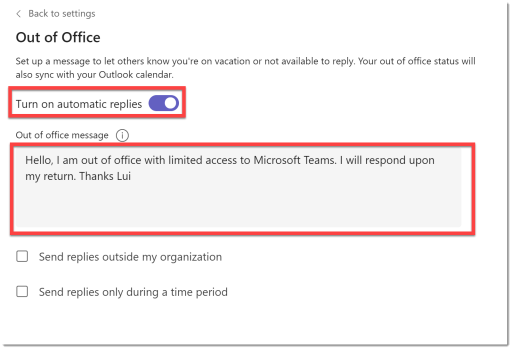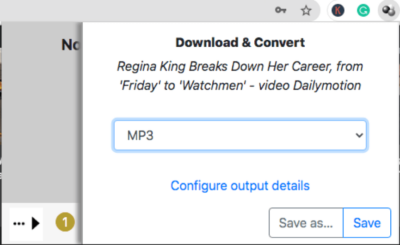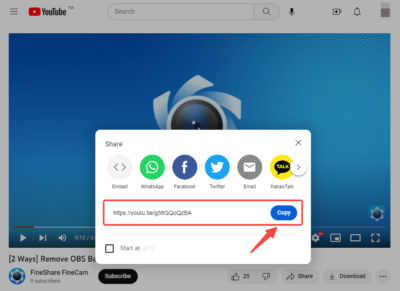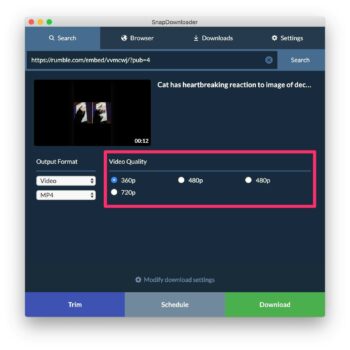Microsoft Teams, as a robust collaboration platform, offers the Out of Office feature to enhance communication efficiency. Let's delve into a comprehensive understanding of how this functionality works and its implications for team dynamics.
Out of Office in Microsoft Teams serves as a virtual indicator of a user's availability status. When activated, it informs team members that the user is temporarily away and may not respond promptly. This feature is especially valuable in remote work scenarios where team members may be distributed across different time zones.
Key Features:
- Status Indicator: The Out of Office status is prominently displayed, ensuring visibility to colleagues.
- Customizable Messages: Users can craft personalized Out of Office messages to provide context for their absence.
- Automated Notifications: Team members receive automatic notifications when attempting to contact an Out of Office user.
- Time-based Activation: Users can set specific time frames for their Out of Office status, allowing for flexibility.
Activation Process:
- Access Microsoft Teams and navigate to the user profile settings.
- Locate the Out of Office option and toggle it to the "On" position.
- Select the desired time frame for the Out of Office status to remain active.
- Compose a personalized message to inform colleagues of the reason for the absence.
- Save the settings to apply the Out of Office status.
Use Cases:
Out of Office in Microsoft Teams is applicable in various scenarios:
| Scenario | Use |
|---|---|
| Remote Work | Alerting team members to potential delays in response due to different work hours. |
| Personal Time Off | Indicating extended leaves or vacations to manage team expectations. |
By understanding the intricacies of Out of Office in Microsoft Teams, users can harness its power to foster a more transparent and collaborative virtual work environment.
How to Set Out of Office in Microsoft Teams

Configuring your Out of Office status in Microsoft Teams is a straightforward process that ensures your team members are informed of your temporary unavailability. Here's a step-by-step guide to help you seamlessly activate this feature:
- Login to Microsoft Teams: Open the Teams application and log in with your credentials to access your profile settings.
- Navigate to Profile Settings: Locate your profile picture or initials in the upper-right corner and click on it. From the dropdown menu, select "Set status message."
- Toggle Out of Office: In the status message pop-up, find the "Out of Office" option. Toggle the switch to the "On" position to activate the Out of Office status.
- Set Time Frame: Choose the duration for which you want the Out of Office status to remain active. You can select a specific time range to automatically turn off the status after a set period.
- Compose Out of Office Message: Craft a personalized message to provide context for your absence. This message will be visible to your colleagues when they attempt to contact you.
- Save Settings: Once you have configured the Out of Office settings and composed your message, save the changes to apply the new status.
Best Practices:
- Ensure your Out of Office message is concise, informative, and includes alternative contacts if necessary.
- Update your status proactively, especially before taking extended leaves or vacations.
- Regularly review and adjust your Out of Office settings based on your availability.
Table of Out of Office Statuses:
| Status | Description |
|---|---|
| Available | User is actively online and ready to engage. |
| Out of Office | User is temporarily away and may not respond immediately. |
| Offline | User is not online and will not receive messages. |
By following these simple steps and adhering to best practices, you can effectively manage your Out of Office status in Microsoft Teams, fostering clear communication within your team.
Also Read This: Shutterstock Alternatives: Exploring Other Stock Photography Platforms
Customizing Out of Office Messages
Personalizing your Out of Office messages in Microsoft Teams adds a human touch to your virtual communication, providing context to your absence. Let's explore the ways in which you can customize these messages for various scenarios:
Steps to Customize Out of Office Messages:
- Access Profile Settings: Log in to Microsoft Teams and navigate to your profile settings by clicking on your profile picture or initials in the upper-right corner.
- Activate Out of Office: Toggle the Out of Office switch to the "On" position to enable the customization options.
- Compose Personalized Message: In the message editor, craft a message that clearly communicates your absence. Include information such as the reason for your unavailability, expected return date, and any alternative contacts if applicable.
- Use Emphasizing Elements: Employ bold text to highlight crucial details in your message. For example, emphasize the dates of your absence or specific points that require attention.
- Consider Multilingual Messages: If your team is diverse, consider providing Out of Office messages in multiple languages to ensure everyone can easily understand the information.
- Preview Message: Before saving the changes, take advantage of the preview option to see how your message will appear to your colleagues.
- Save and Apply: Once satisfied with your customized Out of Office message, save the changes to apply the new settings.
Best Practices for Crafting Messages:
- Keep the message concise and focused on essential information.
- Express gratitude for understanding and provide reassurance regarding your availability upon return.
- Update the message to reflect changes in your circumstances or return dates if needed.
Example Out of Office Message:
Subject: Out of Office
Message: Hi Team,
I'm currently out of the office due to [reason]. I'll be back on [return date]. For urgent matters, please contact [alternative contact]. Thank you for your understanding!
By customizing your Out of Office messages thoughtfully, you contribute to a more transparent and considerate communication culture within your team in Microsoft Teams.
Also Read This: Why Are Alamy Images So Expensive? Factors Affecting Pricing and Value
Setting Time Frames for Out of Office
Flexibility is key when it comes to managing your availability in Microsoft Teams. Setting time frames for your Out of Office status allows you to automate the activation and deactivation of this feature based on your schedule. Let's explore how to tailor these time frames to suit your needs:
Configuring Time Frames:
- Login to Microsoft Teams: Access the Teams application and log in with your credentials to initiate the customization process.
- Access Profile Settings: Click on your profile picture or initials in the upper-right corner and navigate to the profile settings.
- Activate Out of Office: Toggle the Out of Office switch to the "On" position to reveal the time frame settings.
- Set Start and End Times: Specify the start and end times for your Out of Office status. This ensures that the feature is active only during specific periods of the day.
- Choose Days of the Week: Select the days of the week for which you want the Out of Office status to be active. This is particularly useful for part-time schedules or non-standard working hours.
- Preview and Confirm: Utilize the preview option to review your configured time frames. Confirm your settings to apply the specified schedule for your Out of Office status.
Benefits of Time-based Activation:
- Automate your Out of Office status based on your regular work hours.
- Ensure that your status accurately reflects your availability, reducing the likelihood of misunderstandings.
- Enhance work-life balance by clearly defining periods of availability and non-availability.
Example Time Frame Configuration:
| Start Time | End Time | Days Active |
|---|---|---|
| 09:00 AM | 05:00 PM | Monday to Friday |
By leveraging the time frame settings in Microsoft Teams, you can align your Out of Office status with your work schedule, ensuring that your online presence accurately reflects your availability to colleagues.
Also Read This: A Must Try Tool for Video Enthusiasts to Save from Likee
Notifications and Alerts During Out of Office
Ensuring effective communication even when you're away is crucial. Microsoft Teams provides robust notification and alert mechanisms when a user is marked as Out of Office. Let's explore how these features work and how they contribute to seamless team collaboration:
Automatic Notifications:
When a team member attempts to contact you while your Out of Office status is active, Microsoft Teams generates automatic notifications to inform them of your temporary unavailability. These notifications serve as a proactive measure, reducing the likelihood of delayed responses and setting clear expectations.
Alerts for Incoming Messages:
Users interacting with your chat or attempting to mention you in a channel receive alerts indicating your Out of Office status. This ensures that colleagues are promptly informed and can adjust their expectations accordingly, fostering a responsive and understanding communication culture.
Alternative Contacts:
As part of your Out of Office message customization, consider including information about alternative contacts who can assist during your absence. This proactive approach enables colleagues to reach out to the designated contacts for urgent matters, ensuring continuity in communication and tasks.
Best Practices for Notifications:
- Clarity in Out of Office Message: Craft a clear and concise Out of Office message that provides information about your absence and suggests appropriate actions.
- Timely Updates: If there are changes in your return date or availability, update your Out of Office settings promptly to align with the current situation.
- Encourage Team Awareness: Promote awareness within your team about the significance of Out of Office notifications and the role they play in maintaining efficient communication.
Example Notification Message:
Notification: [Your Name] is currently marked as Out of Office and may not respond immediately. For urgent matters, please contact [Alternative Contact].
By leveraging the notification and alert features in Microsoft Teams, users can navigate through the challenges of team collaboration with confidence, even when key members are temporarily away.
Also Read This: Freight Fulfillment: A Guide on How to Ship Freight on eBay
FAQ
Explore answers to frequently asked questions about setting Out of Office in Microsoft Teams to streamline your understanding of this valuable feature:
Q: How do I activate Out of Office in Microsoft Teams?
A: Navigate to your profile settings, toggle the Out of Office switch to the "On" position, set the desired time frames, compose a personalized message, and save the changes.
Q: Can I customize my Out of Office message?
A: Yes, you can craft a personalized message to provide context for your absence, including the reason for your unavailability, expected return date, and any alternative contacts if applicable.
Q: Are there specific time frames for activating Out of Office?
A: Microsoft Teams allows users to set specific start and end times for their Out of Office status, providing flexibility to align with their work schedule.
Q: What happens when someone tries to contact me while I'm marked as Out of Office?
A: Automatic notifications are generated to inform the contacting party of your temporary unavailability. Alerts are also triggered for incoming messages, ensuring colleagues are promptly aware of your status.
Q: Can I include alternative contacts in my Out of Office message?
A: Yes, it is recommended to include information about alternative contacts who can assist during your absence. This proactive approach ensures continuity in communication and tasks.
Q: Is there a preview option for my Out of Office message?
A: Yes, before saving your Out of Office message, you can utilize the preview option to see how it will appear to your colleagues, allowing you to make any necessary adjustments.
Q: How can I encourage team awareness about Out of Office notifications?
A: Promote the importance of Out of Office notifications within your team, emphasizing the role they play in maintaining efficient communication. Encourage timely updates and clear message crafting.
By addressing these frequently asked questions, users can navigate the Out of Office settings in Microsoft Teams with confidence, ensuring a smooth and informed communication experience for themselves and their teams.
Also Read This: Top Benefits and Usage of Linkedin
Best Practices for Using Out of Office
Optimizing the use of Out of Office in Microsoft Teams contributes to effective communication and team collaboration. Here are some best practices to ensure you make the most out of this valuable feature:
- Regular Updates: Keep your Out of Office settings up-to-date. If there are changes in your availability or return date, update the information promptly to align with your current situation.
- Clear and Concise Messages: Craft Out of Office messages that are clear, concise, and provide essential information. Include the reason for your absence, expected return date, and any alternative contacts if applicable.
- Time Frame Alignment: Set time frames for your Out of Office status that align with your regular work hours. This ensures that your online presence accurately reflects your availability to colleagues.
- Alternative Contacts: Encourage users to include information about alternative contacts in their Out of Office messages. This proactive step ensures continuity in communication and tasks during their absence.
- Proactive Awareness: Promote team awareness about the significance of Out of Office notifications. Encourage team members to be mindful of these notifications and adjust their communication expectations accordingly.
- Personalization: Take advantage of the customization options available. Personalize your Out of Office message to add a human touch, making it more considerate and understanding for your colleagues.
- Timely Activation: Activate your Out of Office status proactively, especially before taking extended leaves or vacations. This ensures that your team members are well-informed in advance.
By adhering to these best practices, users can leverage the Out of Office feature in Microsoft Teams to create a transparent and collaborative virtual work environment. These practices enhance communication efficiency, promote team understanding, and contribute to a positive and considerate team culture.
Conclusion
In conclusion, mastering the Out of Office feature in Microsoft Teams is a key aspect of fostering effective communication and collaboration within virtual teams. By understanding the functionalities, customization options, and best practices associated with Out of Office, users can navigate remote work challenges with ease.
Setting Out of Office messages with clear and concise information ensures that team members are aware of your temporary unavailability and can adjust their expectations accordingly. The ability to customize messages, set specific time frames, and provide alternative contacts adds a layer of personalization and consideration to virtual interactions.
Utilizing the automatic notifications and alerts during Out of Office status enhances team awareness and reduces the likelihood of delayed responses. Encouraging team members to follow best practices, such as regular updates and proactive communication, contributes to a positive and efficient virtual work culture.
By embracing these features and practices, Microsoft Teams users can create a seamless and transparent virtual workspace, where communication flows smoothly even when team members are temporarily away. The Out of Office feature becomes a valuable tool for maintaining collaboration, ensuring productivity, and fostering a supportive team environment.
In the ever-evolving landscape of remote work, leveraging the capabilities of tools like Microsoft Teams becomes essential. The Out of Office feature stands as a testament to the platform's commitment to facilitating efficient and considerate communication in the digital era.














